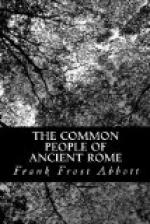To pass to another possibility, it is very tempting to see a connection between the Satirae of Petronius and the prologue of comedy. Plautus thought it necessary to prefix to many of his plays an account of the incidents which preceded the action of the play. In some cases he went so far as to outline in the prologue the action of the play itself in order that the spectators might follow it intelligently. This introductory narrative runs up to seventy-six lines in the Menaechmi, to eighty-two in the Rudens, and to one hundred and fifty-two in the Amphitruo. In this way it becomes a short realistic story of every-day people, involving frequently a love intrigue, and told in the iambic senarius, the simplest form of verse. Following it is the more extended narrative of the comedy itself, with its incidents and dialogue. This combination of the condensed narrative in the story form, presented usually as a monologue in simple verse, and the expanded narrative in the dramatic form, with its conversational element, may well have suggested the writing of a realistic novel in prose. A slight, though not a fatal, objection to this theory lies in the fact that the prologues to comedy subsequent to Plautus changed in their character, and contain little narrative. This is not a serious objection, for the plays of Plautus were still known to the cultivated in the later period.
The mime gives us still more numerous points of contact with the work of Petronius than comedy does.[86] It is unfortunate, both for our understanding of Roman life and for our solution of the question before us, that only fragments of this form of dramatic composition have come down to us. Even from them, however, it is clear that the mime dealt with every-day life in a very frank, realistic way. The new comedy has its conventions in the matter of situations and language. The matron, for instance, must not be presented in a questionable light, and the language is the conversational speech of the better classes. The mime recognizes no such restrictions in its portrayal of life. The married woman, her stupid husband, and her lover are common figures in this form of the drama, and if we may draw an inference from the lately discovered fragments of Greek mimes, the speech was that of the common people. Again, the new comedy has its limited list of stock characters—the old man, the tricky slave, the parasite, and the others which we know so well in Plautus and Terence, but as for the mime, any figure to be seen on the street may find a place in it—the rhetorician, the soldier, the legacy-hunter, the inn-keeper, or the town-crier. The doings of kings and heroes were parodied. We are even told that a comic Hector and Achilles were put on the stage, and the gods did not come off unscathed. All of these characteristic features of the mime remind us in a striking way of the novel of Petronius. His work, like the mime, is a realistic picture of low life




